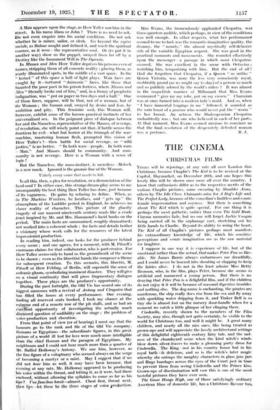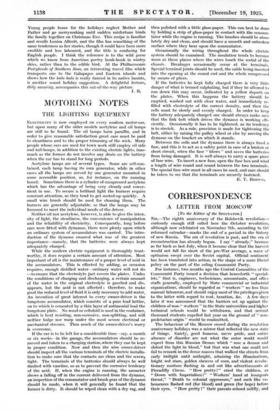THE CINEMA
CHRISTMAS FILMS
THERE will be rejoicings, at any rate all over London this Christmas, because Chaplin's The Kid is to be revived at the Capitol, Haymarket, on December 28th, and one hopes this lovely film will be shown once more all over the country. I know that enthusiasts differ as to the respective merits of the various Chaplin pictures, some swearing by Shoulder Arms, others by The Idle Class. Claimants arise for A Dog's Life and The Perfect Lady, because of the comedian's faultless and comic female impersonation and coyness. But there is something about The Kid which is quite special. For one thing it is perhaps the most pathetic, sadder than even The Gold Rush. Cinema memories fade, but no one will forget Jackie Coogan being carried off in the orphanage cart, stretching out his little hands to Charlie. Beyond its ability to wring the heart, The Kid of all Chaplin's pictures perhaps most manifests his extraordinary knowledge of life, which his sensitive perceptions and comic imagination use as the raw material for laughter.
I suppose in one way it is experience of life, but of the emotional rather than the actual, that makes Peter Pan so like- able. Sir James Barrie always embarrasses me dreadfully, and I could never be hoaxed into shouting or clapping to keep the fairies alive. I do not in the least admire Miss Betty Bronson, who, in the film, plays Peter, because she seems so artificial and mannered a young person. But there is no denying that Peter Pan is a delightful film, and if the children do not enjoy it it will be because of seasonal digestive troubles and nothing else. The dog-nurse is enchanting, the pirates are murderous, the ship really does rise from the sea and fly away with sparkling water dripping from it, and Tinker Bell is so tiny she is almost lost on the nursery door-handle when for a moment we catch a little glimpse of her clinging there.
Cinderella, recently shown to the members of the Film Society, may also, though not quite certainly, be visible to the world for Christmas too, and well it might be. A great many children, and nearly all the nice ones, like being treated as grown-ups and will appreciate the lovely architectural settings of this delightful eighteenth century fairy tale, and the sad- ness of the churchyard scene when the kind witch's winds blow down silver -heaves to make a gleaming party dress for Cinderella. The King—mot in his country house but in his royal bathis -delicious, and so is the witch's later magic whereby she entraps the naughty. characters in glass jam jars and flings bandages across the eyes of the Court just in time to prevent them from seeing Cinderella and the Prince kiss. Grown-ups of discrimination will vow this is one of the most tasteful pictures they have ever seen.
The Goose Hangs High, one of those satisfyingly Ordinary American films of domestic life, has a Christmas flavour too, Young people home for the holidays neglect Mother and Father and go merrymaking until sudden misfortune binds the family together on Christmas Eve. This recipe is familiar and recalls Louisa Allcott, and the film has something of the same tenderness as her stories, though it could have been more credible and less laboured, and the title is confusing for English people. I think the reference is to the wild geese which we know from American poetry honk-honk in wintry skies, rather than to the edible bird. At the Philharmonic Fairylands of Southern Seas, an interesting travel film which transports one to the Galapagos and Eastern islands and shows how the hula hula is really danced in its native haunts, is another sound holiday suggestion. A delightful lecture, drily amusing, accompanies this out-of-the-way picture.
I. B.















































 Previous page
Previous page